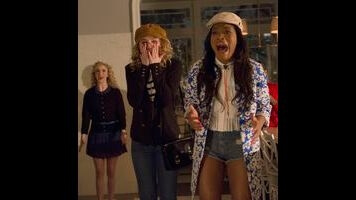Ryan Murphy’s Scream Queens is like a rocky, horror-filled Glee

Ryan Murphy announced Fox’s Scream Queens in a manner befitting his brand: He declared the camptastic anthology series the genesis of a heretofore unseen genre called “comedy horror.” Ornery internet haters—also known as reasonable people with a cursory knowledge of horror—cried foul and lambasted Murphy in the name of comedy horror trailblazers such as Sam Raimi and Joe Dante. In Murphy’s semi-defense, his claim wasn’t born out of ignorance or grandiosity, it was further proof of his eerily proficient showmanship.
Murphy is an unparalleled salesman, and smart money says he’s fully aware that he’s not the first storyteller to marry laughter and fright, but he doesn’t much care. Murphy has a knack for artfully trolling the media and galvanizing the sizable fan base he’s accumulated over his years working on Nip/Tuck, Glee, and American Horror Story. For his steadfast super fans, all Murphy has to do to invent comedy horror is say he did. But conceptual prowess and keen marketing instincts lose their potency in service of a stale product. And even Murphy apologists may cool to Scream Queens, a patchwork of his earlier series that barely feels like a new show, much less a new genre.
Queens bears a structural resemblance to AHS from its first scene, a tantalizing vignette set in 1995. A horrific incident at the ivy-walled Wallace University serves as a prologue to the present-day campaign to discover who is killing off the sisters of Kappa Kappa Tau sorority, clad in a cherry-red devil costume. Emma Roberts stars as Chanel, the sadistic tyrant atop the food chain at KKT, Wallace’s most prestigious and most exclusive sorority. Chanel relishes her malicious monarchy, which gives her domain over a trio of weak-willed KKT sisters whose names she can’t be bothered to learn. Instead, in a nod to Heathers, she refers to them as extensions of herself: ditzy Chanel #2 (Ariana Grande), haughty Chanel #3 (Billie Lourd), and cruel Chanel #5 (Abigail Breslin). KKT’s toxic way of life—which resembles Jawbreaker: The College Years—comes under attack from anti-Greek dean Cathy Munsch (Jamie Lee Curtis). Munsch wants desperately to strip KKT of its charter, but she settles for stripping the club of its exclusivity by forcing KKT to accept anyone who wants to join.








































